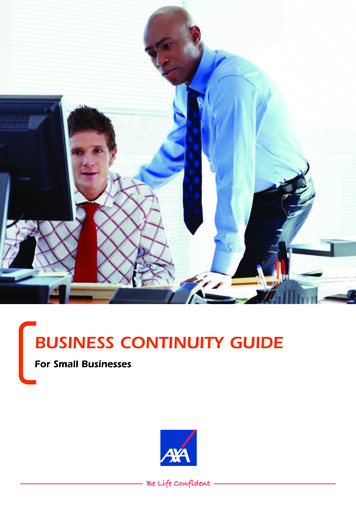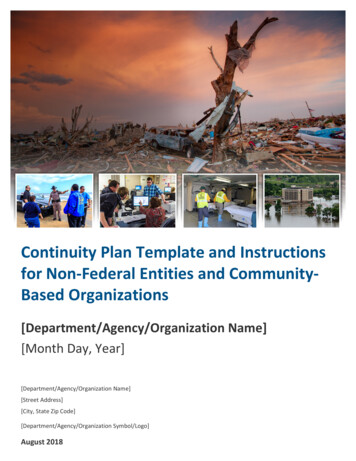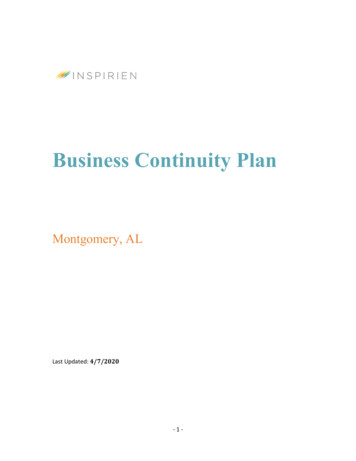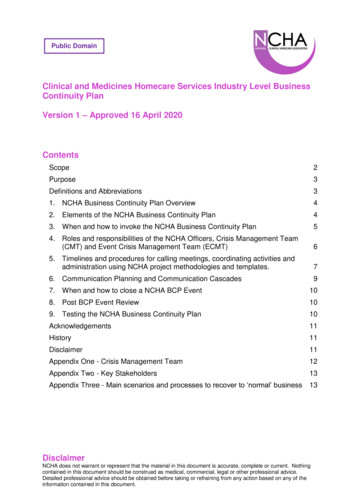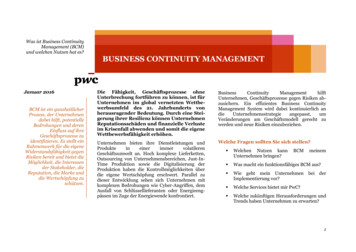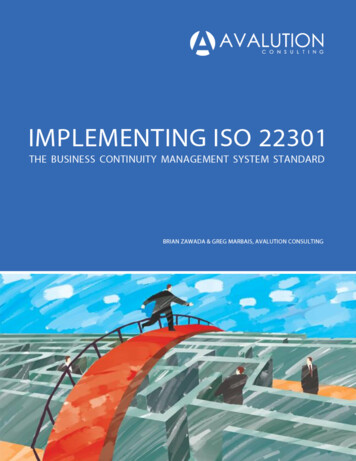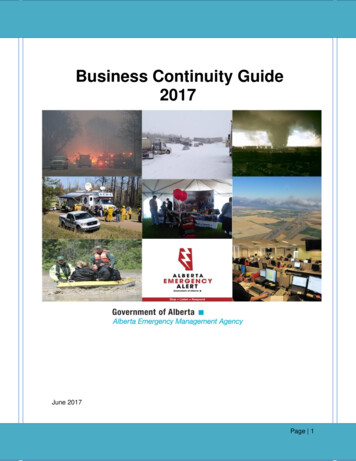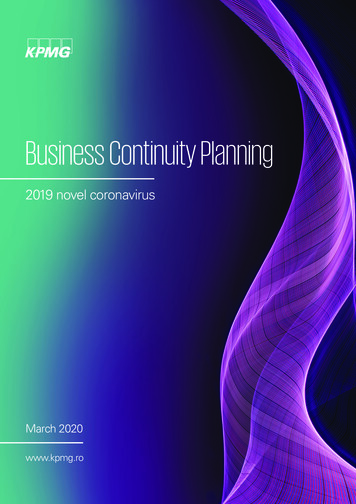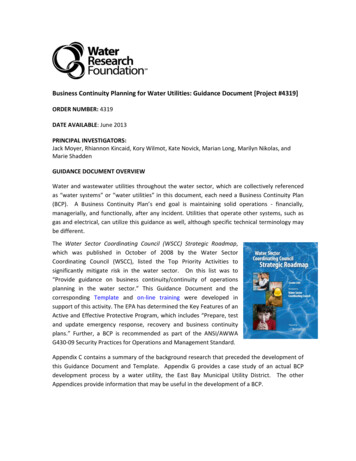
Transcription
Business Continuity Planning for Water Utilities: Guidance Document [Project #4319]ORDER NUMBER: 4319DATE AVAILABLE: June 2013PRINCIPAL INVESTIGATORS:Jack Moyer, Rhiannon Kincaid, Kory Wilmot, Kate Novick, Marian Long, Marilyn Nikolas, andMarie ShaddenGUIDANCE DOCUMENT OVERVIEWWater and wastewater utilities throughout the water sector, which are collectively referencedas “water systems” or “water utilities” in this document, each need a Business Continuity Plan(BCP). A Business Continuity Plan’s end goal is maintaining solid operations ‐ financially,managerially, and functionally, after any incident. Utilities that operate other systems, such asgas and electrical, can utilize this guidance as well, although specific technical terminology maybe different.The Water Sector Coordinating Council (WSCC) Strategic Roadmap,which was published in October of 2008 by the Water SectorCoordinating Council (WSCC), listed the Top Priority Activities tosignificantly mitigate risk in the water sector. On this list was to“Provide guidance on business continuity/continuity of operationsplanning in the water sector.” This Guidance Document and thecorresponding Template and on‐line training were developed insupport of this activity. The EPA has determined the Key Features of anActive and Effective Protective Program, which includes “Prepare, testand update emergency response, recovery and business continuityplans.” Further, a BCP is recommended as part of the ANSI/AWWAG430‐09 Security Practices for Operations and Management Standard.Appendix C contains a summary of the background research that preceded the development ofthis Guidance Document and Template. Appendix G provides a case study of an actual BCPdevelopment process by a water utility, the East Bay Municipal Utility District. The otherAppendices provide information that may be useful in the development of a BCP.
About the BCP Template and Video Training ModulesThe Guidance Document is designed to be used with the corresponding BCP Template (referredto throughout this document as the Template) to assist users in the development of a BCP for awater utility. While the Template makes it easier for utilities to get started developing their ownBCP, a BCP should be customized for a specific utility, as needed, so that it can be mosteffective. To further enhance an understanding of the Business Continuity Planning process, aseries of video training modules was developed to accompany the BCP guidance document andtemplate. These modules correspond to the various sections of the written materials. Usersmay view the entire video or select individual modules, as appropriate to their needs.In addition to these tools, a Business Case Analysis tool was developed to assist utilities inevaluating the business case for developing a BCP. This tool is included as Appendix A, and isintended to be used by any utility needing to prove a return on investment for a BCP program.The callout boxes throughout this document provide guidance on how to customize the BCP forany size of utility. The water drops throughout both documents help users keep track ofinformation in the Guidance Document that corresponds to the Template. These drops shouldbe removed from the final BCP after plan development.A BCP is not meant to replace any other emergency management document, or to replicate anyother document. It should complement and enhance a water utility’s existing emergencymanagement system as shown in Figure 1. Generally, the BCP will be a plan that pulls otherexisting plans together, although a water utility may choose to integrate their BCP into anexisting plan or vice versa.
Figure 1: BCP Relationship with Other PlansAn emergency response plan (ERP) or similar emergency plan is a tool that “stops the bleeding,”while a BCP is a tool that keeps the “heart pumping”. Regarding the distinction between a BCPand a Continuity of Operations Plan (COOP), while there are historical distinctions, the two areincreasingly interchangeable as more and more organizations plan for and mitigate disruptionsto their operations. This Guidance Document and Template address the concepts of both BCPand COOP.
A list of plans that may complement the BCP are listed below in Table 1, and a glossary ofnotable types of preparedness plans is included in Appendix J.Type of PlanHazard Mitigation PlansIncluded DocumentsVulnerability Assessment / Risk AnalysisBusiness Impact Analysis (BIA)Impact AssessmentHazard IdentificationRisk Mitigation Plan (RMP)Standard Operating Procedures tosupport Mission Essential FunctionsDocumentation PolicyTimekeeping ProceduresSafety and Security PlansPreparedness PlansFacility Response Plan (FRP)Hazard-Specific Preparedness Plan (e.g., Hurricane, Flood)Spill Prevention Control and Countermeasure (SPCC)Response PlansEmergency Response Plan (ERP)Emergency Operations Plan (EOP)Fire Evacuation PlansIncident Management PlansCrisis Communications Plan (CCP)Point of Dispensing (POD) PlanHazard-Specific Response Plan (e.g., Flood, Tornado, Bomb-Threat,Water Quality Emergency)Recovery PlansCOOPLaboratory COOPPandemic PlanInformation Technology (IT) Disaster Recovery Plan (DRP)Table 1: Plan RelationshipsReal World Examples of Where a BCP Fits Relative to Other PlansOne large utility uses the BCP as their central plan, and includes other emergency management plansin the appendices of that central plan. During and after an incident, this one document has all of theneeded information.Another utility has the BCP as an annex to their ERP. This layout also allows users to access onedocument with all of the information that is needed in an emergency.Many utilities have their ERP and BCP as separate stand‐alone documents.All three scenarios presented are effective because they were developed with the culture and needsof the respective utilities in mind.
Why is a BCP critical?Why invest in developing a BCP? Besides being a prudent business practice, some additionaljustifications for developing a BCP include: Address gaps in the existing emergency management system, particularly associated withfinancial and business functions of the utility.Pull together existing plans.Address an item that is listed as a “Top Priority Activity” in the WSCC Strategic Roadmap.Provide guidance for any interruption in business, such as power outages or supplyinterruptions.Provide policies and procedures restoring mission essential functions after an incident.Reduce downtime and associated costs.Strengthen a utility’s ability to continue serving critical customers during an emergency.Improve resource management.Improve reputation management.Keep employees engaged and employed.Improve a utility’s ability to survive through any size of incident.BCP Management SystemA management system is the framework of processes and procedures used to ensure that anorganization can effectively fulfill all tasks required to achieve its objectives. It is recommendedthat a business continuity program use a management system approach to ensure that the planis effective and continually improved.In supporting the management systems approach, the “Plan‐Do‐Check‐Act” cycle is presented inFigure 2: PLAN – Establish management system policy, objectives, processes, and proceduresrelevant to managing business continuity risks and improving response and recoveryprocesses that deliver results in accordance with the organization’s strategic needs.DO – Implement and operate the management system policy, controls, processes, andprocedures.CHECK – Monitor, assess, measure, and review performance against managementsystem policy, objectives, and practical experience; report the results to managementfor review; and determine and authorize actions for remediation and improvement.ACT – Take corrective and preventive actions, based on the results of the internalmanagement system audit and management review, re‐appraising the scope of the
business continuity management system and business continuity policy and objectivesto achieve continual improvement of the management system.1PlanActDoCheckFigure 2: Plan, Do, Check, Act CycleCultureFor business continuity planning to be effective and to meet the requirements of Section 4.1 ofthe ANSI/AWWA G430 Standard, it needs to become part of the utility’s organizational culture.2Every organization, including water utilities, has a culture. Although culture is intangible andoften taken for granted, it provides a core set of values and assumptions, and guides day‐to‐dayactivities of personnel in the workplace. 3Organizational cultures that have been developed over many years are generally difficult, butnot impossible, to change. Certain conditions encourage change, such as turnover in leadershipor experiencing a significant crisis, such as a catastrophic incident. 4 Too often, it is not until suchan incident occurs that an organization changes their practices in emergency management andbegins developing a BCP. In these cases, business continuity planning is typically embraced inearnest.1ASIS (American Society for Industrial Security) International and BSI (British Standards Institution). 2010.Business Continuity Management Systems: Requirements with Guidance for Use. ASIS/BSI BCM.01‐2010.Approved November 2, 2010.2BCI (Business Continuity Institute). 2010. Good Practice Guidelines 2010. Berkshire, United Kingdom:BCI.3Deal, T.E., and Kennedy, A.A. 1983. Culture: A New Look through Old Lenses.” Journal of AppliedBehavioral Science, 19(4): 501.4Chapter 16 of Robbins, S. 2003. Essentials of Organizational Behavior, New Jersey: Pearson Education,Inc.
A catastrophic incident is not necessary to shift a culture. Once water utility leadership commitsto developing a BCP, there are best practices to change the culture and make the plan moreeffective. Key practices to facilitate this shift include:Utilizing top management role models – Employees will look to the behavior of top managementas a benchmark. When senior management promotes business continuity planning for the sakeof mission continuity and serves as active participants in the process, it provides a clear messageto all employees.Encouraging employee participation – Provide employees access to business continuity planningdocuments in accordance with security protocols and include employee representatives from allkey business areas in business continuity planning meetings.Providing business continuity training – Provide training, workshops, and exercises tocommunicate each employee’s roles and responsibilities under the business continuity program.Recognizing value of business continuity – After the BCP is activated during an exercise or realincident, it is important to review performance and provide constructive feedback to businesscontinuity participants not only to develop recommendations for improvement, but also torecognize the value of past business continuity planning efforts.It is important to remember that such cultural change needs to be measured in years, notmonths.Business Continuity Planning CommitteeIn most utilities, multiple people will need to provide input in the BCP development process. Forthe purposes of this document, the people providing input on the BCP Development arereferred to as the Business Continuity Planning Committee. More guidance on the BusinessContinuity Planning Committee is provided in Section 2.0How to Use the Guidance Document, BCP Template, and Training ModulesThe Guidance Document is meant to be used with the BCP Template and Video TrainingModules. The information here should be used as guidance. Users should also think beyond theexamples and suggestions given. Not all portions of this Guidance Document and the Templatewill apply to all water utilities. BCP developers should utilize what works best for them.Each section of the Template corresponds to a section in the Guidance Document. TheGuidance Document gives explanations, examples, and other information that helps developersof a BCP use the Template. It should be noted that there are call‐out boxes throughout thedocument to provide guidance on how to scale certain aspects of the BCP depending on the sizeof the utility, or to provide real world examples of how different aspects of the businesscontinuity planning process have been implemented by different water utilities. Additionally,certain supplemental materials that may help with the collection of information for the BCPdevelopment have been provided in the appendices of this document.
In the corresponding Template, there are empty tables and bullets. If additional rows areneeded in the tables, hit the “Tab” key while the cursor is in the bottom right cell, and anadditional row will appear. A checklist for the completion of the section is included at the endof each section of the Template – this is for the user’s review, and is not to remain in the utility’sfinal BCP document.The appendices of the Guidance Document are to assist with the development of the BCP anddo not correspond directly to the appendices of the Template, which are examples ofsupplemental materials for the BCP. Section 13 of the Guidance Document providesinformation on the development and incorporation of the BCP appendices and annexes.Appendix F of this Guidance Document addresses the maintenance of a BCP.These documents are provided to assist with the development of a BCP to help utilities be moreresilient in the face of sudden incidents that impact the utility and its mission essentialfunctions. The goal of these documents is to simplify the process, but input and evaluation bystakeholders is necessary for the BCP to be effective.Research Partners AWWAU.S. Environmental Protection Agency
business continuity management system and business continuity policy and objectives to achieve continual improvement of the management system.1 Figure 2: Plan, Do, Check, Act Cycle Culture For business continuity planning to be effective and to meet the requirements of Section 4.1 of
